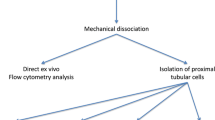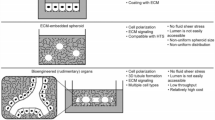Summary
A stable epithelial-like pig kidney cell strain has been established. This strain has been carried through more than 300 serial passages, has remained free of microbial and viral contaminants, and has retained a near diploid number of chromosomes. Attempts to produce tumors with these cells in immunosuppressed laboratory animals have been uniformly negative. The cells have grown rapidly in monolayer cultures with a split ratio of 1 to 15 at weekly intervals, but have failed to proliferate in suspension cultures. A subline adapted to growth on serum-free medium 199 has been carried through 145 passages on this medium. Several unusual morphologic features have been observed in these cultures including three-dimensional “domelike” structures. These cells have been found susceptible to some viruses and have been especially useful for viruses of domestic animals. LLC-PK1 cells have produced significant levels of plasminogen activator.
Similar content being viewed by others
References
Harris, M. Personal communication. PK15 is a strain of cells cloned by Dr. Harris from a parent strain of pig kidney cells obtained from Dr. E. Stice, Cutter Laboratories.
Inoue, Y. K., and M. Yamada. 1964. Clonal line of porcine kidney stable cells for assay of Japanese encephalitis virus. J. Bacteriol. 87: 1239–1240.
Clapman, W. G., and I. A. Ramshaw. 1971. Growth of the IB-RS-2 pig kidney cell line in suspension cultures and its susceptibility to foot and mouth disease virus. Appl. Microbiol. 22: 1–5.
Kasza, L., J. A. Shadduck, and G. J. Christofinis. 1972. Establishment, viral susceptibility and biological characteristics of a swine kidney cell line SK-6. Res. Vet. Sci. 13: 46–51.
Gil-Fernandez, C. 1970. The susceptibility of the “Ferran” strain of pig kidney cells to virus infection. Microbiol. Esp. 23: 203–219.
Gavrilov, V. I., D. M. Asher, and S. D. Vyaluskina. 1972. Persistent infection of a continuous line of pig kidney cells with a variant of the WSN strain of influenza A0 virus. Proc. Soc. Exp. Biol. Med. 140: 109–117.
Younger, J. S. 1954. Monolayer tissue cultures. I. Preparation and standardization of suspensions of trypsin-dispersed monkey kidney cells. Proc Soc. Exp. Biol. Med. 85: 202–205.
Morton, H. C. 1970. A survey of commercially available tissue culture media. In Vitro 6: 89–108.
Evans, V. J., W. R. Earle, K. K. Sanford, J. E. Shannon, and H. K. Waltz. 1951. The preparation and handling of replicate tissue cultures for quantitative studies. J. Natl. Cancer Inst. 11: 907–927.
Sanford, K. K., W. R. Earle, V. J. Evans, H. K. Waltz, and J. E. Shannon. 1951. The measurement of proliferation in tissue cultures by enumeration of cell nuclei. J. Natl. Cancer Inst. 11: 773–795.
Cherry, W. R., and R. N. Hull. 1960. Studies and observations on the growth of mammalian cells in agitated fluid medium. J. Biochem. Microbiol. Technol. Eng. 2: 267–285.
Tjio, J. H., and T. T. Puck. 1958. Genetics of somatic mammalian cells. II. Chromosomal constitution of cells in tissue culture. J. Exp. Med. 108: 259–268.
Moorhead, P. S., and P. C. Nowell. 1964. Chromosome cytology. In: H. N. Eisen (Ed.),Methods in Medical Research. Volume 10. Yearbook Medical Publications, Chicago, pp. 310–322.
Sigel, M. M., T. M. Scotti, M. A. Wryk, and M. Dorsey, Jr. 1958. Tubule formation in rat brains by monkey kidney cells previously grown in vitro. Nature 182: 1034–1035.
Astrup, T. and S. Mullwitz. 1952. The fibrin plate method for estimating fibrinolytic activity. Arch. Biochem. Biophys. 40: 346–351.
Auersperg, N. 1969. Histogenetic behaviour of tumors. I. Morphologic variations in vitro and in vivo of two related human carcinoma cell lines.
McGrath, C. M., and P. B. Blair. 1970. Immunofluorescent localization of mammary tumor virus antigens in mammary tumor cells in culture. Cancer Res. 30: 1963–1968.
McFee, A. F. 1967. In: T. C. Hsu and K. Benirschke (Eds.),An Atlas of Mammalian Chromosomes. Volume 1, Folio 38. Springer-Verlag, New York.
Gorham, L. W., and C. Waymouth. 1965. Differentiation in vitro of embryonic cartilage and bone in a chemically-defined medium. Proc. Soc. Exp. Biol. Med. 119: 287–290.
Kitos, P. A., R. Sinclair, and C. Waymouth. 1962. Glutamine metabolism by animal cells growing in a synthetic medium. Exp. Cell Res. 27: 307–316.
Waymouth, C. 1959. Rapid proliferation of sublines of NCTC clone 929 (strain L) mouse cells in a simple chemically defined medium (MB 752/1). J. Natl. Cancer Inst. 22: 1003–1017.
Eagle, H. 1959. Amino acid metabolism in mammalian cell cultures. Science 130: 432–437.
Morrison, S. J., and H. M. Jenkin. 1972. Growth ofChlamydia psittaci strain meningopenumonitis in mouse L cells cultivated in spinner culture employing a defined medium. In Vitro 8: 94–100.
Hull, R. N., and O. J. Tritch. 1962. Characterization of cell strains by viral susceptibility. Natl. Cancer Inst. Monogr. 7: 161–171.
Hull, R. N., W. R. Cherry, and O. J. Tritch. 1962. Growth characteristics of monkey kidney cell strains LLC-MK1, LLC-MK2 and LLC-MK2 (NCTC-3196) and their utility in virus research. J. Exp. Med. 115: 903–918.
Hull, R. N., and R. M. Huseby. 1975. Enhanced production of plasminogen activator. U. S. Patent No. 3904480.
Woods, W. A., T. S. Papas, H. Hirumi, and M. A. Chirigos. 1973. Antigenic and biochemical characterization of the C-type particle of the stable porcine kidney cell line PK-15. J. Virol. 12: 1184–1186.
Ruddle, F. H. 1961. Chromosome variation in cell populations derived from pig kidney. Cancer Res. 21: 885–894.
Hayflick, L. 1967. Oncogenesis in vitro. Natl. Cancer Inst. Monogr. 26: 355–377.
Author information
Authors and Affiliations
Additional information
Histopathological examinations of animal tissues were done by Dr. C. G. Culbertson. Tests for mycoplasma were performed by Mr. D. H. Holmes.
Rights and permissions
About this article
Cite this article
Hull, R.N., Cherry, W.R. & Weaver, G.W. The origin and characteristics of a pig kidney cell strain, LLC-PK1 . In Vitro Cell.Dev.Biol.-Plant 12, 670–677 (1976). https://doi.org/10.1007/BF02797469
Issue Date:
DOI: https://doi.org/10.1007/BF02797469




